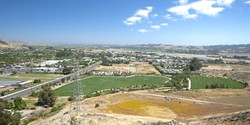If there’s any lesson to be learned from this story, it’s this: Don’t drink from purple water hydrants. Another lesson: Nothing about water is simple.
Take a long stroll in the southern parts of the city of San Luis Obispo, and you’ll likely spot the occasional purple water hydrant. Unlike traditional uses of the color—royalty, luxury, and sometimes the Lakers—this use of purple means whatever you do, don’t drink the water from the well. Purple indicates the hydrant contains water recycled from raw sewage. In other words, it’s not for human consumption.

- PHOTO BY STEVE E. MILLER
- TROUBLED : Recycled water has been playing havoc with the Damon Garcia sports fields.
The fleet of purple hydrants is part of a vast web of pipes that supply city parks and a few businesses with treated wastewater. The pipes and hydrants are part of the city’s water recycling system, a $10 million network completed in 2006 and designed to provide 1,000 acre-feet of water to an expanding city.
Unfortunately, the program hasn’t worked out the way it was intended.
The system only provides 10 percent of the water it was designed to handle, and the recycled water it provides hasn’t agreed with the turf at some of the city’s parks.
The system seems an odd investment for a city swimming in water. In fact, the city has more water than it would need even if it were twice its size, due to the recent addition of the Lake Nacimiento pipeline’s output.
The idea for a recycling system was born in the 1990s when droughts were ravaging the city and the future looked very dry.
“We are in very unique position,” said Ron Munds, conservation and recycling supervisor for the city. “We have a water supply reliability and supply that may
be unique.”
The system’s layout may seem strange—at least to people not used to the way the city allocates its resources. The pipes delivering the recycled water spread south from the treatment plant at Prado Road and then branch northwest to deliver water to the Irish Hills Plaza. Another line slinks to the west to the Santa Margarita and Orcutt areas.
No recycling pipes head north into the heart of the city, where most people live. Most of the system’s water lines run adjacent to or terminate in areas that are vacant. However, these are areas designated for future development.
“They thought those areas would have already been developed when the system was designed,” said a SLO official who asked to remain anonymous. “Now they have lots of water available, but few customers.”
The nameless official and others in SLO City Hall say there are plans in the works to sell the recycled water to wineries in the Edna Valley, which would bring in money to make the program profitable.
Oddly enough, no one seems to know how much the program costs.
“We have not quantified that fully,” said Carrie Mattingly, head of the city’s utilities department. “That’s one of our goals next year, and we will be looking at the rates we charge for the water.”
The largest customer for the water is, by far, the city itself.
A few big box stores and banks buy the water to irrigate their landscaping. Customers (including the parks department) pay 90 percent of what they would pay for normal water.
Most of the city’s parks manage well with the recycled water. Others, like the Damon Garcia sports fields, have problems with the stuff.
Parks Maintenance Supervisor Todd Beights is in charge of the fields and much of the city’s landscaping. A computer in his office beeps and chimes on a regular basis, noisily managing much of the city’s irrigation systems.
Maintaining the Damon Garcia fields has never been easy, and they suffer from much bigger problems than the recycled water, Beights said. The base soil is sandy, and since the field’s construction in 2006, there have always been issues with the grass.
Unfortunately for the city, the fields weren’t designed with recycled water in mind. The water, rich in nitrates and salts, has made the grass difficult to manage.
According to a June 2010 city report, the recycled water was high in chlorides, electrical conductivity, and salt.
“The sodium accumulates in the soil. It slows down percolation so that little oxygen [gets] deep and the end result is shallow-rooted turf that can’t defend itself,” stated the report.
The report indicates that nitrates in the water also cause the grass to grow much faster than normal, which triggers more maintenance headaches. The water usually destroys native plant species. There was talk of replacing the fields with Astroturf, but that step was deemed too expensive.
Beights has been fighting to keep the fields going. The city installed a state-of-the-art irrigation system to help deal with the petulant turf.
“We take soil samples, tissue samples from the turf, and send them in for analysis,” Beights explained. “We receive back a fertility report, which steers us in the right direction … then we use the irrigation system to distribute elements
if need be.”
The fields require a lot of maintenance. The parks department usually shuts them down for months in the late fall and winter to work on the turf and give the grounds a rest from play. In June, the department closed the fields for two months, and Beights hopes that move will do the trick for this year.
Beights said he isn’t sure how much money goes to compensating for what the recycled water does to the fields, but he seems confident he can deal with the recycled water.
“My park system was the guinea pig for this mandate,” he said. “It’s more of a burden, more of a challenge, but we’ve managed it well.”
Staff Writer Robert A. McDonald can be reached at [email protected].
Comments